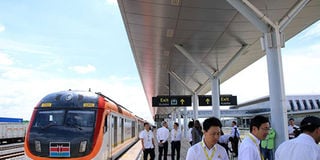Complete Naivasha leg and turn town into regional transport hub

A Madaraka Express train arrives in Nairobi on April 27, 2019. The standard gauge railway project has become a veritable albatross around the neck of the Kenyan economy. PHOTO | FILE | NATION MEDIA GROUP
What you need to know:
- We must make the Mombasa-Syokimau route really work in the truest commercial sense and make it as attractive as possible for cargo transport.
- We must complete the second leg to Naivasha as soon as possible and with a less abrasive approach to the inhabitants of the relevant areas affected.
The failure of the Kenyan government to secure funding for the Naivasha to Malaba section of the standard gauge railway (SGR) gives the country an opportunity to reflect on and review this overly ambitious and highly expensive project.
One of Kenya’s greatest assets is its regional hub status. We are the gateway to landlocked countries in the region and the conduit for their imports and exports. This earns the country a lot of money and is one of the major drivers of our economy.
It therefore makes sense to improve our hub infrastructure as much as possible so as to consolidate and expand this gateway status.
The old railway operation has had a chequered history largely due to mismanagement and lack of investment, and so road transport had played an increasing role in transporting cargo from Mombasa to the region.
ALBATROSS
Road transport is convenient as it’s a seamless carriage from port to ultimate destination. But our road infrastructure has had an expensive battering as a result.
The concept of trying to get much of that transport back onto railway wagons makes sense. The catch is at what cost, and that is where the SGR project comes unstuck.
The SGR project has become a veritable albatross around the neck of the Kenyan economy.
Its gargantuan cost, both in terms of construction and running, has resulted in an expensive loss-maker. Remember the debt spreads three ways: interest, hefty principle repayments that start kicking in shortly, and operational losses.
It is good to stand away from the government propaganda machine and see where we are at and where we could or should go.
An alternative railway line had been on the cards for some time and, indeed, the project proposal had been tendered twice.
So had the idea of rehabilitating the old medium gauge railway, but the hitch with the latter was the amount of money needed to restore a very run-down operation.
LOSS-MAKING
For reasons best left to speculation, the tenders for a new SGR were never actualised into real projects and an opaque government-to-government deal for the SGR was negotiated.
It was single-sourced with the relevant financial and mechanical details being agreed behind closed Chinese doors.
How the exercise in deciding who should do the relevant feasibility study, the design, the construction and running the operation itself and how the costing was done are all hanging open questions.
What we got was a single, non-electric railway line at arguably twice the price it should have been, a crippling debt, and a day-to-day operation complete with around 5,000 Chinese personnel, which is losing money day in, day out.
The government says it will start to make money in the not-too-distant future. Some analysts say it’s likely to lose money for the next decade or two.
TURNAROUND
Only the Mombasa to Syokimau stretch is operating. Whilst passenger numbers have increased at a healthy pace, the cargo loads are well below official anticipations.
The Syokimau to Naivasha construction has been mired in controversy. Now we’re told there’s no funding for the Naivasha-Malaba stretch, and Transport Secretary James Macharia would have us believe we can overcome that with the stop-gap measure of using the old, rusting and non-functioning railway line.
He needs to come down from cloud cuckoo land and travel along what’s left of the vandalised line, complete with massive encroachment.
He should visit the stations that have been turned into offices, cafés, restaurants and kiosks. At night, he can even visit a night club on one of the premises!
What’s the way forward? First, we must make the Mombasa-Syokimau route really work in the truest commercial sense and make it as attractive as possible for cargo transport.
DEBT
We must drive down the operational costs and the number of Chinese expatriates on it. However, it must retain the competence and efficiency that the Chinese contractors have instilled in it.
We must complete the second leg to Naivasha as soon as possible and with a less abrasive approach to the inhabitants of the relevant areas affected.
On the debt issue, the government is between a rock and a hard place. It must renegotiate this so that it’s doable and manageable.
This is in the interests of both China and Kenya. The debt default route would be a highly contentious and unpopular one and could well cause much anger and hostility, particularly towards China and its many operations in the country.
A feasibility study on reviving the old Naivasha-Malaba stretch is in order, but we must bear in mind that the latter would take time and borrowed money.
Naivasha must be turned into a transport hub so road hauliers could pick up and transport cargo to the relevant country and regional destinations and vice-versa.
The more cautious and prudent Chinese government lending approach may have done us a good turn. It is a pity it did not come earlier.
Robert Shaw is a public policy and economic analyst. [email protected]





